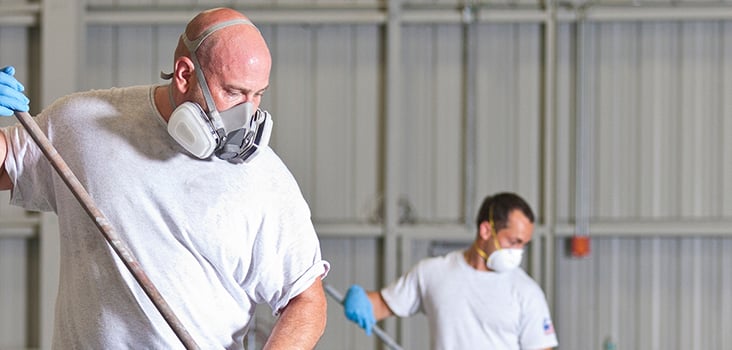
What Does a Respirator Fit Test Consist Of?
If your employees work in a hazardous environment with harmful dusts, fumes, gases, etc., the Occupational Safety and Health Administration (OSHA) requires them to wear respirators. A respirator protects the wearer against toxic atmospheres, allowing them to breathe with reduced exposure to respirable toxins. But before an employee uses a respirator, they must complete a medical examination and respirator fit test.
With new regulatory standards for silica exposure, more employees are now required to wear respirators. If you’re new to the process, or just need a refresher, here’s a brief overview of how to prepare for and what to expect with a respirator fit test.
How to Prepare for a Respirator Fit Test
Before an employee starts their respirator fit test, there are a few items they need to prepare beforehand.
- Select a respirator. When choosing a respirator, employers should consider what toxins the employee is exposed to, the concentration of the toxins, job responsibilities, time spent exposed, and more. The equipment must be NIOSH-certified. The employee will need to bring the chosen respirator to their fit test.
- Bring protective equipment. If the employee wears any other personal protective equipment (PPE) that could interfere with the respirator’s seal, they must bring those items to the fit test. This can include safety glasses, hearing protection, face shields, hard hats, and coveralls.
- Shave. Your male employees will need to be clean-shaven for their respirator fit test. OSHA requires this because facial hair can interfere with a respirator’s fit.
- Complete a medical evaluation questionnaire. OSHA required a medical evaluation before any employee can be fit-tested for a respirator. The employee will need to complete an OSHA Respirator Medical Evaluation Questionnaire, which the employer is required to provide time for their employee to complete. The employee needs to bring the completed questionnaire to their respirator fit test, as it must be reviewed by a physician or other licensed health care provider (PLHCP).
What the Respirator Fit Test Covers
The respirator fit test will start with a medical evaluation, where the PLHCP will review the completed questionnaire and provide the employee and employer with a written recommendation. The fit test administrator does not require a specific certification, but they do need to be trained on how to conduct the test.
The PLHCP’s recommendation will cover three things:
- Whether the employee is medically able to wear the respirator, and if they have any medical limitations for using it
- Whether the employee requires any follow-up medical evaluations
- A statement saying the employee and employer have been provided with a copy of the recommendation
If the employee is cleared to wear a respirator, they will go through one of two fit tests: a qualitative fit test or a quantitative fit test.
What does a qualitative fit test cover?
A qualitative fit test (QLFT) can only be used to test negative pressure respirators and tight fitting face pieces used with powered and atmosphere-supplying respirators. It’s a pass/fail test that relies on the respirator user’s senses.
There are four OSHA-accepted test agents:
- Isoamyl acetate
- Saccharin
- Bitrex®
- Irritant smoke
The respirator’s filter determines which agent is tested.
For the respirator fit test, the respirator user will perform seven exercises for one minute each:
- Normal breathing
- Deep breathing
- Moving head side to side
- Moving head up and down
- Bending over
- Talking
- Normal breathing again
If the worker doesn’t detect any odor or irritation during these exercises, the fit test is passed and the worker is safe to wear their respirator.
What does a quantitative fit test cover?
A quantitative fit test (QNDT) can be used to test any tight-fitting respirator, ensuring that there’s a proper seal to protect the user. The test uses an instrument to measure leakage around the face seal, resulting in a number called the “fit factor.”
There are three OSHA-accepted test protocols:
- Using a non-hazardous aerosol in a test chamber (called generated aerosol)
- Using ambient aerosol without a test chamber (called condensation nuclei counter)
- Creating a vacuum that temporarily cuts off air (called controlled negative pressure)
The quantitative fit test requires the respirator user to perform the same seven exercises as the qualitative test, with an additional grimace test where the worker smiles or frowns for 15 seconds.
The leakage measurement on the test, or the fit factor, determines whether the employee is safe to use their respirator. A fit factor of at least 100 is needed for half-mask respirators, while a fit factor of at least 500 is needed for full facepiece negative-pressure respirators.
Concentra provides qualitative fit tests at all of our locations nationwide, and offers quantitative fit tests at select locations. Our clinicians can ensure that you comply with the new silica regulations, and that your employees are safe and healthy on the job. Talk to a Concentra representative to send your employees for respirator fit tests.



